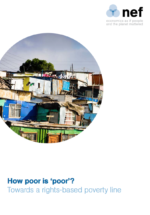How poor is ‘poor’?
Towards a rights-based poverty line
04 July 2010
Poverty is usually defined by the ‘$1‑a-day’ line developed by the World Bank. But does definition this tell the whole story? This report argues that we need a broader approach, based on human rights, which takes into account actual living standards.
The World Bank’s estimates of global poverty, based on the “$1‑a-day” line, have been a major intellectual and technical feat. There can be little doubt that they have also had a major political impact in putting poverty on the international agenda.
However, there are a number of important issues underlying the methodology by which they are produced, raising questions about the accuracy and reliability of the picture they present of the level, composition and trends of global poverty.
- It focuses exclusively on income (or more precisely consumption).
- It sets the poverty line at an essentially arbitrary level.
- Poverty estimates are critically dependent on the base year used for price indices, which should make no difference.
- The “$1‑a-day” line itself, used as the basis for policy, embodies an implicit moral judgment that this level of income is morally acceptable, which is at best highly questionable.
- It imposes inconsistent standards between countries in terms of living standards, which vary very widely between people living at “$1‑a-day” in different countries.
- The conversion factors used to translate poverty lines into local currency incomes are inappropriate, giving much greater weight to the prices of goods and services bought by non-poor than by poor people.
- Purchasing power parity (PPP) estimates for many countries have been based on estimates rather than measurement (although this has improved markedly since the paper was written).
- Updating the poverty line over time is problematic, for example failing to reflect differences in inflation as between rural and urban areas.
There are further problems in the estimation of poverty in those years in which no surveys have been conducted; and the method of estimating poverty since the last survey are systematically skewed, so that they risk exaggerating the rate of poverty reduction in recent years.
Important as it has been to put poverty onto the global agenda, if the figures on which our view of poverty is based are potentially misleading, then we are in serious danger of adopting the wrong policies. More specifically, given the nature of the methodological problems, we are in danger of being lulled into complacency that the thrust of our global economic system is broadly consistent with reducing, and ultimately eradicating poverty.
We argue that a less arbitrary approach to defining poverty needs to be based on defining an income level consistent with a standard of living which we consider the minimum morally acceptable level. This can in principle be based either on an “inputs” approach (the cost of accessing what is needed to fulfil basic needs), or on an “outcomes” approach (the level of incomes associated in practice with minimum acceptable levels of indicators of physical well-being).
Each of these approaches can be adopted either globally, to produce a single universal poverty line (cf the “$1‑a-day” line), or on a country-by-country basis, to generate a poverty line for each country. This gives us four broad categories of non-arbitrary poverty lines.
We review four alternative approaches to defining poverty, corresponding to three of these categories:
- Kakwani and Son’s International Food Poverty Line (global/input-based);
- Peter Edward’s Ethical Poverty Line (global/outcome-based); and
- Morris et al’s Minimum Income for Healthy Living, and Reddy et al’s Capability-Based Approach (country-specific/input-based)
However, each of these approaches is, in different ways, problematic.
We therefore propose a new approach to the definition of poverty, which we call the Rights-Based Poverty Line (RBPL), based on the fourth and final category – a country-specific outcomes-based approach.
The RBPL approach is based on the estimated statistical relation between income and indicators of well-being which correspond to different economic and social rights (health, nutrition, education, etc). By setting a single universal threshold level of the indicator concerned, and establishing the income at which that level is actually achieved in each country, we can in principle define a poverty line for each country which is at a different level of income, but gives rise to an equivalent standard of living in each country.
This approach, we argue, both avoids the issues arising from “input-based” approaches and resolves the problems inherent in any global poverty line defined in terms of incomes, while maintaining consistency between countries. We present estimates of RBPLs for six countries (Bolivia, Eqypt, India (rural and urban), Nicaragua, Senegal and South Africa) using the infant mortality rate as an indicator of the right to child survival, based on four alternative threshold levels. This demonstrates the wide range of incomes required to achieve equivalent living standards in different countries.
Having established a set of poverty lines, there are two ways in which poverty can be reduced – either by increasing incomes to the level at which rights are fulfilled, or by reducing the income required to fulfil each right.
The picture of poverty this approach presents is much more complex than those generated by other approaches, and particularly the single “poverty headcount” (and largely ignored “poverty gap”) figures generated by approaches based on a single global poverty line defined in “dollars per day”.
In the RBPL approach, we have multiple dimensions of poverty – health, nutrition, education, housing, access to water and sanitation, etc. In each of these dimensions, we have four indicators – the poverty line itself, the proportion of the population below it, the poverty gap (reflecting the extent to which incomes are below the RBPL) and the rights gap (indicating the extent to which rights are not fulfilled as a result of poverty).
However, this complexity is inevitable if we are to obtain a meaningful picture of the multi-faceted issue of global poverty, and we present a simple graphical approach to present poverty comparisons between countries and over time.
Through this approach, the RBPL can provide us with much more relevant information than the simple headline figures of “dollar-a-day” approaches. For example, we can distinguish the extent to which poverty arises from low incomes and from low living standards at a given level of incomes in each country, and assess the relative importance in each case of income generation and (for example) improving access to health services or education; we can identify priority areas in which access to services most needs to be improved for low-income households; and we can avoid the misleading interpretation that poverty is falling where rising incomes are off-set by falling living standards relative to income.
At present, the data are not available to estimate RBPLs for all developing countries; and what data exist are far from ideal for the purpose. We therefore present proposals for meeting the data requirements for a more comprehensive and reliable application, building on existing approaches. In view of the potential advantages of this approach it terms of presenting a fuller, more nuanced and potentially more accurate picture of global poverty – which would seem essential to effective policy-making for its reduction – the relatively limited cost of such data improvements would represent a very worthwhile investment.
Topics Wellbeing







